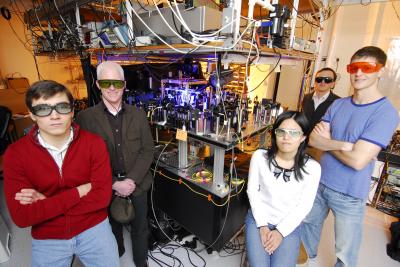In order to be useful, quantum computers will eventually need to be linked together over large distances. Quantum computing relies on the transmission of entangled qubits, or "quantum bits," over distance in the form of photons. The existing fiber optic network of the United States is adequate to provide the transmission lines, but as photons travel along the lines they degrade steadily. Therefore, a device that can read and retransmit the signal would allow for the transmission of quantum data over any distance.
New research by physicists at the Georgia Institute of Technology has brought a quantum repeater device one step closer to reality. The team was able to store quantum information for 7 milliseconds - 2 orders of magnitude longer than the previous record of 32 microseconds.

Bright Future: The Georgia Tech team stands beside the device that broke the quantum storage record. Photo Credit: Georgia Institute of Technology.
In order to function properly, a quantum repeater needs to be able to store information briefly and then re-encode and retransmit it. Until now, a major limitation has been the amount of time data can be stored in memory.
Alex Kuzmich, an associate professor in the Georgia Tech School of Physics, said of the breakthrough: "This is a really significant step for us, because conceptually it allows long memory times necessary for long-distance quantum networking ... For multiple architectures with many memory elements, several milliseconds would allow the movement of light across a thousand kilometers."
The Georgia Tech team used rubidium-87 atoms as the basis for their quantum memory. To keep them relatively still, the atoms were cooled to near absolute zero and trapped in something called an optical lattice. An optical lattice uses laser beams of different frequencies, shining in the same area, to create energy "buckets" that hold atoms in place. The lattice can be tuned to place atoms where they are desired. Optical lattices have been used for other purposes in the past, such as to study exotic materials, but this is the first time one has been used to extend the lifetime of quantum memory.

Potential Buckets: An artists' rendition of an optical lattice. The red spheres are atoms sitting in the energy "buckets" created by interfering laser beams. Photo Credit: Wikipedia.
"The most critical aspect to getting these long coherence times was the optical lattice," said Stewart Jenkins, one of the participating research scientists. "Although atoms had been confined in optical lattices before, what we did was to use this tool in the context of implementing quantum memory."
To encode information on to the atoms, a laser beam carrying a signal is shined on the array of atoms confined to the lattice. Each atom stores a portion of the quantum information, which is sensitive to the relative locations of the atoms. The lattice, therefore, allows the information to be stored longer by preserving the locations of the atoms more effectively.
Jenkins stressed that the lattice makes reading the data easier, also. "The advantage of using these ensembles as opposed to single atoms is that if we shine into them a 'read' laser field, because these atoms have a particular phase imprinted on them, we know with a high degree of probability that we are going to get a second photon – the idler photon – coming out in a particular direction. That allows us to put a detector in the right location to read the photon."
Kurzwich warns that quantum computing may still be a long way off. So far, none of the quantum effects needed for a quantum computer or network have been demonstrated outside of the laboratory.
"In practice, you will need to make robust repeater nodes with hundreds of memory elements that can be quickly manipulated and coupled to the fiber," he said. "There is likely to be slow progress in this area with researchers gaining better and better control of quantum systems. Eventually, they will get good enough so we can make a jump to having systems that can work outside the laboratory environment."




Comments